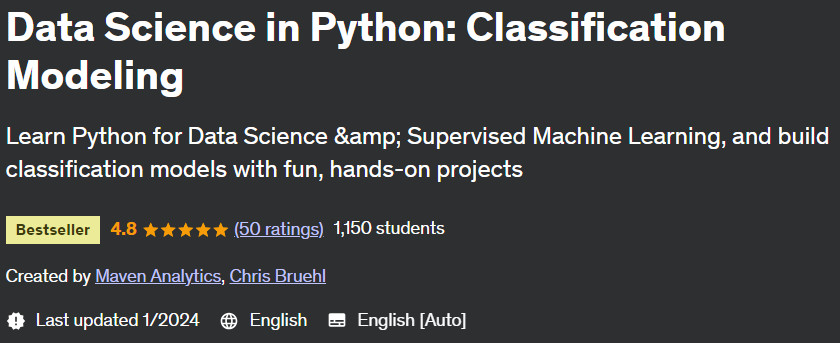Description
Data Science in Python: Classification Modeling course. Data Science Course in Python: Categorical Modeling. This is a hands-on, project-based course designed to help you master the basics of categorical modeling in Python. We’ll start with an overview of data science workflows, discuss the primary goals and types of classification algorithms, and take an in-depth look at the classification modeling steps we’ll use throughout the course. You will learn to perform exploratory data analysis, use feature engineering techniques such as scaling, dummy variables, and binning, and prepare data for modeling by splitting it into train, test, and validation datasets. From there, we adapt K-Nearest Neighbors and logistic regression models and develop intuition for interpreting their coefficients and evaluating their performance using tools such as confusion matrices and metrics such as accuracy, precision, and recall. We will also cover techniques for modeling unbalanced data, including thresholding, sampling methods such as oversampling and SMOTE, and adjusting class weights in the model’s cost function. During the course, you will play the role of data scientist for the risk management department at Maven National Bank. Using the skills you learn throughout the course, you’ll use Python to explore their data and build classification models to accurately determine which customers are high, medium, and low credit risk based on their profiles. Last but not least, you will learn to build and evaluate decision tree models for classification. You’ll adapt, visualize, and fine-tune these models using Python, then apply your knowledge to more advanced ensemble models such as random forests and gradient-boosted machines. Summary of the course:
- An introduction to data science
- Introduce the fields of data science and machine learning, review essential skills, and introduce each step of the data science workflow.
- Classification 101
- Review the basics of classification, including key terms, types and purposes of classification modeling, and modeling workflows.
- Pre-Modeling Data Prep & EDA
- Review the data preparation and EDA steps required to perform modeling, including key techniques for target discovery, attributes, and relationships.
- K-nearest neighbors
- Learn how the k-nearest neighbor (KNN) algorithm classifies data points and practice building KNN models in Python.
- logistic regression
- Introduce logistic regression, learn the math behind the model, and practice fitting them and adjusting the regularization power.
- Classification criteria
- Learn how and when to use several important metrics for evaluating classification models, such as precision, recall, F1 score, and ROC-AUC.
- Unbalanced data
- Understand the challenges of modeling unbalanced data and learn strategies to improve model performance in these scenarios
- Decision trees
- Build and evaluate decision tree models, algorithms that look for partitions in your data that best separate your classes.
- Group models
- Learn the basics of ensemble models, then move on to specific models like random forests and gradient boosted machines.
If you are an aspiring data scientist looking for an introduction to the world of classification modeling with Python, this course is for you.
What you will learn in Data Science in Python: Classification Modeling course
-
Master the basics of supervised machine learning and classification modeling in Python
-
Perform exploratory data analysis on model features and objectives
-
Apply feature engineering techniques and divide the data into training, test, and validation sets
-
Building and interpreting k-nearest neighbors and logistic regression models using scikit-learn
-
Evaluate model performance using tools such as confusion matrices and metrics such as accuracy, precision, recall and F1
-
Learn techniques for modeling unbalanced data, including thresholding, sampling methods, and adjusting class weights.
-
Build, tune, and evaluate decision tree models for classification, including advanced ensemble models such as random forests and gradient-boosted machines.
This course is suitable for people who
- Data scientists who want to learn how to build and deploy supervised learning models in Python
- BI analysts or experts looking to learn about classification modeling or move into a data science role
- Anyone interested in learning one of the most popular open source programming languages in the world
Data Science in Python: Classification Modeling course specifications
- Publisher: Udemy
- teacher: Maven Analytics, Chris Bruehl
- Training level: beginner to advanced
- Training duration: 9 hours and 53 minutes
- Number of courses: 171
Course topics on 1/2024
Prerequisites of the Data Science in Python: Classification Modeling course
- We strongly recommend taking our Data Prep & EDA and Regression courses before this one
- Jupyter Notebooks (free download, we’ll walk through the installation)
- Familiarity with basic Python and Pandas is recommended, but not required
Course images
Sample video of the course
Installation guide
After Extract, view with your favorite Player.
Subtitle: None
Quality: 720p
download link
File(s) password: www.downloadly.ir
Size
2.6 GB
